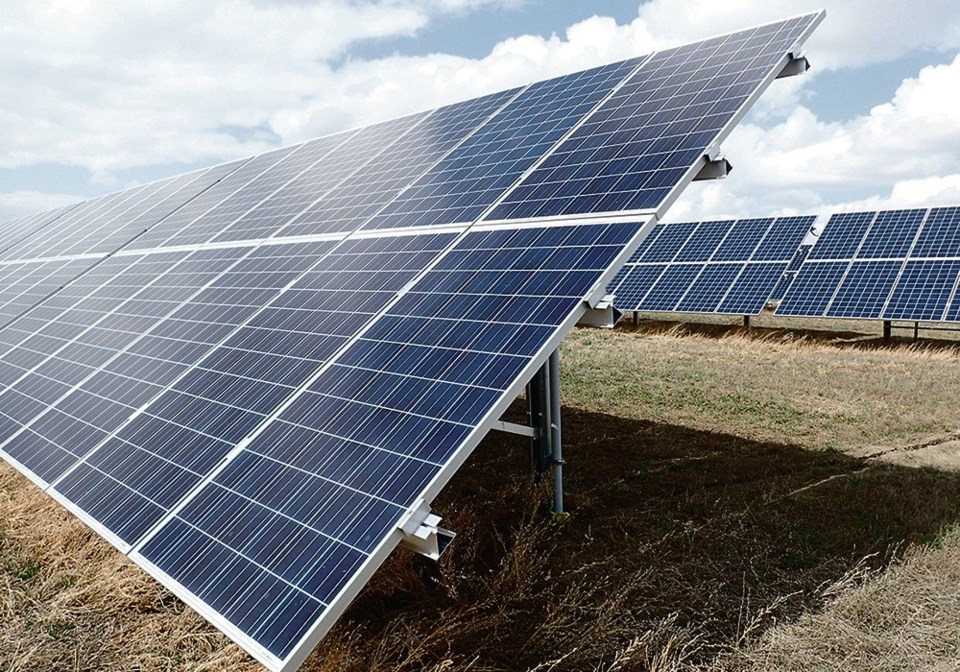Researchers estimate a maximum of less than one tenth of one percent of all agricultural land in Alberta will be required for solar projects under a net zero future for the province’s electrical grid.
The calculation assumes an extreme situation where the projects will be built solely on farmland, said associate professor Sara Hastings-Simon of the University of Calgary’s School of Public Policy. It excludes other types of land, such as former industrial or brownfield sites, she said.
It also ignores potential improvements in solar panel efficiency, or emerging technologies such as agrivoltaics that seek to allow farmers to simultaneously raise crops while hosting solar projects on their land, said Hastings-Simon.
“But we felt that it’s better to make the upper-bound estimate, and then we can think about the ways that that might be smaller.”
The estimate of slightly more than 38,000 acres, or 0.08 percent of total agricultural land, was presented in a one-page policy brief co-authored by Hastings-Simon. It was released Oct. 31 by the School of Public Policy and the university’s Simpson Centre for Agricultural and Food Innovation and Public Education.
Besides examining the impact on total agricultural land in Alberta, the policy brief offered a range of estimates based on the type of farmland. It would be 0.15 percent if all new solar projects were solely established on unirrigated cropland, 0.18 percent if only natural and tame pastures were used, and three percent if it involved irrigated acres alone, said the brief.
Paul McLauchlin, president of the Rural Municipalities of Alberta, said he had heard similar statistics.
“And you know, I never argued the data. It’s what’s between the data.”
He recently met with provincial Agriculture and Irrigation Minister RJ Sigurdson about preserving farmland. An increasingly hungry world is looking to Alberta to increase rather than lower its food production, said McLauchlin.
“Those half a percent or tens of percent that are out there, those lands become extremely valuable in a hotter, drier future as it relates to food production… there are 974,000 (house rooftops) in the cities of Calgary and Edmonton, which would be awesome locations for solar panels and would actually save farmland, and that opportunity really should be visited as well.”
However, McLauchlin also recognized that renewable energy represents a “tremendous opportunity for municipalities and individual farm owners if that is the best use of that land, and if it makes sense… then I fully support that.
“And so, to my members, it’s really having that front end conversation around alternative land use. These are industrial-scale power (projects) and moving land from agricultural to industrial needs to have a public interest conversation.”
The policy brief strengthens the case for solar projects in Alberta, said Evan Wilson, vice-president of policy for Western Canada and national affairs with the Canadian Renewable Energy Association (CanREA).
“I think overall we expected that getting to a net-zero grid and building out the amount of solar that would be required would be a pretty small footprint and this really confirms that assumption.”
Hastings-Simon said research began on the policy brief before a provincial moratorium on new solar and wind projects was announced Aug. 3. The measure was partly implemented because of rural concerns about protecting prime agricultural land.
The policy brief doesn’t look at the “very real” effect of solar projects in terms of local land use, which is something they share with other types of development on farmland, she said. “And those are things that still need to be managed, and managed carefully, but what we really wanted to look at here was just one piece of the puzzle, which is how much land are we talking about on the scale of the land that we have in the province?”
The federal government has committed the national electrical grid to net-zero greenhouse gas emissions by 2035 under its proposed Clean Electricity Regulations. The estimates in the policy brief are based on a model by the Alberta Electrical System Operator, which is a non-profit organization that helps ensure the reliability of power in the province.
It suggests that to achieve a net zero grid by 2035, the current 1.3 gigawatts of solar generation capacity must increase to 5.2 gigawatts through to 2041, said the policy brief. However, the Alberta government said Nov. 3 the federal regulations could compromise grid reliability, describing them as dangerous, unrealistic and ineffective.
The RMA and CanREA have partnered on research into reclamation of renewable energy facilities once they have reached the end of their lifespan, including examining policies elsewhere in North America, said Wilson.
They are also collaborating on how renewable energy and agriculture can be combined through options such as agrivoltaics “to provide comfort that agricultural land is being protected as these projects are being deployed and operated across the province,” he said.
The moratorium will end on Feb. 29, 2024, and the Alberta Utilities Commission is slated to provide a report by the end of March, said Wilson. It will detail the findings and recommendations of an inquiry by the AUC that is currently being held into electricity generation in Alberta, with public input to include the research by RMA and CanREA, he said.
For more information, click here to view the policy brief.



